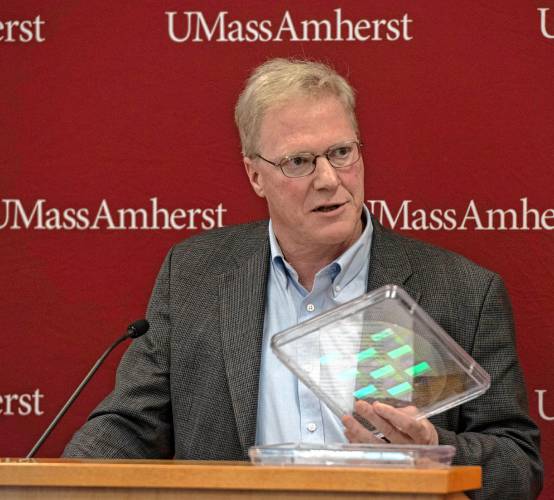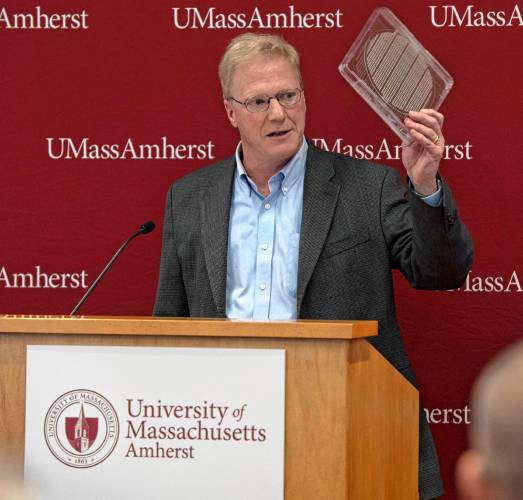During tour with Higher Education Committee, UMass announces a $5M grant for innovative optical lab
| Published: 10-16-2023 5:00 PM |
AMHERST — Within a year, students and researchers in a laboratory at the University of Massachusetts will begin using a nanoimprint lithography tool to craft metal lenses in what will be the first open access facility in the country for the development of advanced optical technology.
The science is being used in technologies ranging from semiconductors to medicine to national defense systems, and from virtual reality to self-driving vehicles.
At the Institute for Applied Life Sciences, where 20 companies, most based in Massachusetts, already work on various research on a daily basis, a $5 million grant announced Friday is providing funding for a full wafer imprint tool to make what James J. Watkins, a professor in the department of Polymer Science and Engineering, says will be “very thin and very functional” metal lenses that, being significantly less expensive, will drive innovation and may reshape machines across the world.
Precision imaging in medicine and lidar, along with applications in biotechnology, defense, aerospace, environmental monitoring and general electronics, are among areas where such optical technology will advance.
“It’s really a chance to move this forward in those fields,” said Watkins, the co-principal investigator, adding that “the excitement is palpable” on campus.
The money for making advancements in manufacture and design optical technologies is coming from the Massachusetts Technology Collaborative’s Innovation Institute and the Collaborative Research and Development Matching Grant program.
The announcement came as Sen. Jo Comerford, D-Northampton, and Rep. David Rogers, D-Cambridge, who co-chair the Joint Committee on Higher Education, began tours that are expected to take them to most public colleges and university campuses across the state, including a visit to Greenfield Community College later on Friday.
Comerford said MassTech’s grant is a “transformative investment” in a part of the state outside the Interstate 495 corridor.
Article continues after...
Yesterday's Most Read Articles
 Cryptozoology exhibits featured at Education Earth Museum
Cryptozoology exhibits featured at Education Earth Museum
 Longtime public servant Richard Sheridan dies at 78
Longtime public servant Richard Sheridan dies at 78
 Athol Royalston Middle School Honor Roll Term 3
Athol Royalston Middle School Honor Roll Term 3
 State Senate budget funds free community college for all
State Senate budget funds free community college for all
 Athol Police Logs: April 12 to April 19, 2024
Athol Police Logs: April 12 to April 19, 2024
 Work on Pinedale Avenue Bridge connecting Athol and Orange to resume
Work on Pinedale Avenue Bridge connecting Athol and Orange to resume
“We know research is vitally important for economic development here in western Massachusetts,” Comerford said.
“This is just a remarkable day,” Rogers said. “As we know, UMass is a research powerhouse.”
Watkins said other parts of the $5 million in funding will go toward the characterization of the lenses, the design of the lenses and the tests of the lenses that Electro Magnetic Applications Inc., a Pittsfield company, will be doing at the Berkshire Innovation Center, where what is produced at the UMass laboratories will be tested under extreme conditions, including simulations of conditions in space.
At Friday’s announcement at the Institute for Applied Life Sciences building, Carolyn Kirk, executive director of MassTech, said it’s a state economic development agency that strengthens the competitiveness technology and innovation sector.
“Massachusetts and the region can’t be more well positioned to seize the opportunities before us,” Kirk said.
Kirk noted other projects MassTech has undertaken, such as the Massachusetts Broadband Institute, which planted 40,000 telephone poles in the region and helped 44 communities get broadband, including Shutesbury, Leverett and New Salem.
The benefits of the development of advanced optical technologies are expected to extend beyond the campus labs by assisting companies for which the work would otherwise be cost-prohibitive.
“It’s really important these dollars have open access and this project absolutely does,” Kirk said. “When we invest in technical training at a leading institution like this, we can expand training opportunities and the talent pipeline to manufacturing careers, helping diversify our workforce and the ability of the state to compete on a global scale.”
The announcement comes on the heels of the state’s recent award of $19.7 million in funding through the federal CHIPS and Science Act to expand production of microelectronics in the Northeast, work that will benefit from increased research and development in related sectors, including advanced optical technologies.
“This grant is truly a momentous opportunity,” said Pat Larkin, director of MassTech’s Innovation Institute.
While doctoral students and technology companies will be trained and have hands-on opportunities in the new lab, students from underrepresented socioeconomic groups at Springfield Technical Community College and Berkshire Community College will also be invited to take part.
UMass Chancellor Javier Reyes said he appreciates that the new laboratory will democratize access to technology, while also creating jobs, and making society better as a result. Reyes said that for 160 years, UMass has been an incubator for revolutionary ideas, and this will accelerate transformative technologies and make them scalable.
“We are proud to be at the forefront of this technological revolution,” Reyes said.
During a brief tour of the current laboratories, Watkins said that the advanced optical technology laboratory will need to be in an even more super clean environment.
Currently, commercial partners come in for a week or for longer periods. The economic development generated through the research is what enables grants and growth in future investments, Watkins said.
“This is the idea, and we’ve been doing it for a while,” Watkins said. “We’d like to have more workforce development.”



 UMass student group declares no confidence in chancellor
UMass student group declares no confidence in chancellor